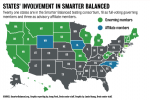A consortium housed in UCLA’s Graduate School of Education and Information Studies is giving a new end-of-the-year test to public school students in California and 17 other states for the first time.
Smarter Balanced, a consortium comprised of more than 20 states, seeks to test students on their knowledge of Common Core standards. Common Core standards, adopted by 43 states, are a set of math and language arts standards for K-12 students with the goal of preparing students for college and careers.
The Smarter Balanced assessment went through field testing last year and the current window for testing began on March 10.
The test, which is done entirely on a computer, focuses on higher-level thinking skills to match the new higher standards of the Common Core, said Luci Willits, deputy executive director of Smarter Balanced. Willits added that she thinks previous end-of-the-year assessments focused more on memorization instead of critical thinking skills.
Smarter Balanced joined UCLA’s GSEIS as an independent operating unit in January. The association formed from a federal grant in 2010, and was looking for a place to continue work after the federal grant ended in September 2014.
Smarter Balanced’s $30 million budget is funded by membership fees from states, including California, that are in the consortium, Willits said.
The consortium is collaborating with a research center within GSEIS called the National Center for Research on Evaluation, Standards and Student Testing. The center offers support and advice on the effectiveness of the test design and how well the assessment reflects the Common Core standards, among other topics, said Li Cai, education professor and co-director of the center.
“This collaboration lets us work together toward a common mission to improve K-12 education in California and beyond,” Cai said.
The assessment is different from past end-of-the-year tests because it is done on a computer, Willits said. Part of the final assessment is computer adaptive where the question a student gets is based on his or her performance on earlier questions, Willits said.
Juniors in high school may see the test impact the courses they take in college. Students starting college in 2016 who earn a certain score on the Smarter Balanced test will be exempt from some development coursework at universities located in states that use Smarter Balanced. The exact score necessary for exemption is still not set.
The center plans to conduct an analysis of the results of Smarter Balanced’s assessments, said center co-director Eva Baker. One goal of the analysis is to see how to improve students’ level of performance on the test, said Baker, a professor in GSEIS. Any suggestions the center makes in the test analysis will be nonbinding changes, she added.
The Smarter Balanced test has faced some criticisms over its use of technology. Steven Rasmussen, a senior associate at SR Education Associates, wrote a critique of the Smarter Balanced math test in March.
Rasmussen said he thinks some of the questions can’t be adequately answered using the current technology provided. He said he thinks the interfaces are confusing and hard for students to use and could be improved with upgraded technology.
“I am a supporter of the Common Core standards for mathematics, but I think there are small and large changes that need to be made before these tests should be used with students,” Rasmussen said.
Willits said she thinks students in the field tests had an easy time navigating the assessment, but they are looking to improve the use of technology in the future.
Cai said one reason the center and GSEIS wanted to be involved with Smarter Balanced is because of the scale of the program.
“This is something that has never been anticipated or attempted with past assessments,” Cai said. “This collaboration allows researchers from our center to play an active role in an assessment that will be serving millions of students across the country.”
